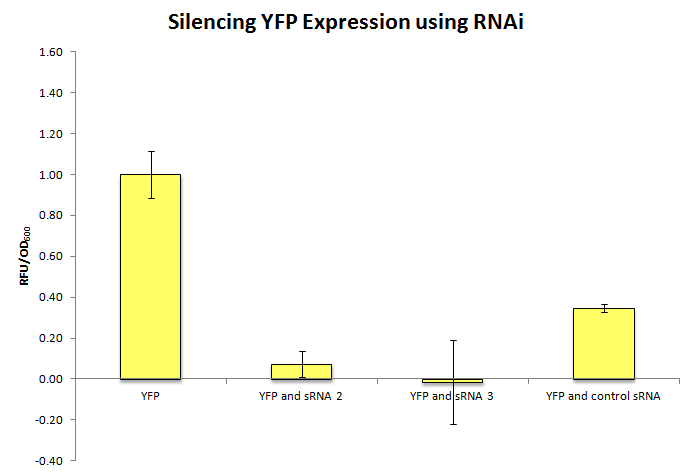Part:BBa_K1323008
sRNA control for S. epidermidis: targets the non-coding region
Small RNAs (sRNAs) are small double-stranded transcripts capable of silencing mRNAs of complementary sequence (Yoo et al., 2013). The sRNA sequence was designed with two functional parts: a region complementary to the target mRNA (target binding site) and MicC scaffold region for recruitment of Hfq BBa_K1323004, a protein which enhances the hybridization between the sRNA and target mRNA (Yoo et al., 2013). The MicC RNA sequence is the best scaffold sequence as shown by previous studies done by the same research group (Na et al., 2013). This is a control sRNA that targets a non-coding region in the genome of S.epidermidis (2314773-2314796) which is a intergenic region that is downstream of two genes on two different strands.
This part was DNA-synthesized by Bio Basic.
This is a control sRNA that targets a non-coding region in the genome of S.epidermidis (2314773-2314796) which is a intergenic region that is downstream of two genes on two different strands. It contains binding energy of only -7.8 kcal/mol to YFP gene as determined using DINAMelt software (http://mfold.rna.albany.edu/?q=DINAMelt/Two-state-melting). For effective binding, sRNA must have binding energy between -30 kcal/mol to -40 kcal/mol (Yoo et al., 2013). This shows that control sRNA cannot effectively bind YFP and it serves as a control which allows us to determine if production of sRNA places a metabolic load on the organism (Dokyun et al., 2013).
Legend
YFP cassette (pSB3K3 backbone, sarA protomer BBa_K1323021,TIR RBS BBa_K1323016, YFP cds BBa_K1323010)
sRNA 2 (BBa_K1323006)
sRNA 3 (BBa_K1323007)
Control sRNA
sRNAi Silencing assay
The YFP cassette and sRNA constructs were co-transformed into DH5α. The control for YFP expression included a sample with only the YFP cassette (no sRNA constructs), and a control sRNA that does not specifically target YFP. Colonies were streak purified and grown in LB supplemented with ampicillin. A restriction digest was run to confirm that both plasmids were in the colonies selected for the antibiotic resistance tests. Overnight cultures, in biological triplicate for each sample, were prepared. 50 µL of overnight culture was used to inoculate fresh media, and once the OD600 reached 0.5-0.6, the YFP fluorescence was measured.
Sequence and Features
- 10COMPATIBLE WITH RFC[10]
- 12COMPATIBLE WITH RFC[12]
- 21INCOMPATIBLE WITH RFC[21]Illegal XhoI site found at 138
- 23COMPATIBLE WITH RFC[23]
- 25COMPATIBLE WITH RFC[25]
- 1000COMPATIBLE WITH RFC[1000]
References
Dokyun Na, S. M. (2013). Metabolic engineering of Escherichia coli using synthetic small regulatory RNAs. Nature Biotechnology, 170-174.
Na, D. et al. (2013). Metabolic engineering of Escherichia coli using synthetic small regulatory RNAs. Nature Biotechnology 31, 170–174.
Yoo, S.M., Na, D., Lee, S.Y. (2013). Design and use of synthetic regulatory small RNAs to control gene expression in Escherichia coli. Nature protocol 8(9), 1694-1707.
| None |

